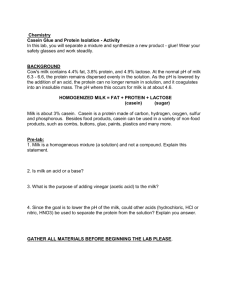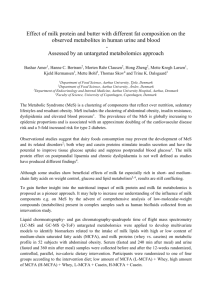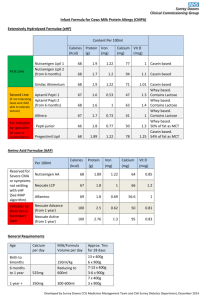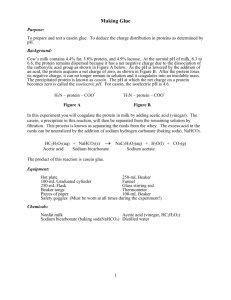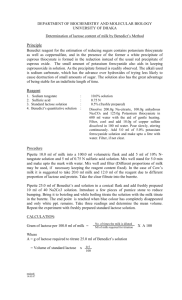Applied Biochemistry Lab BIOC 445
advertisement
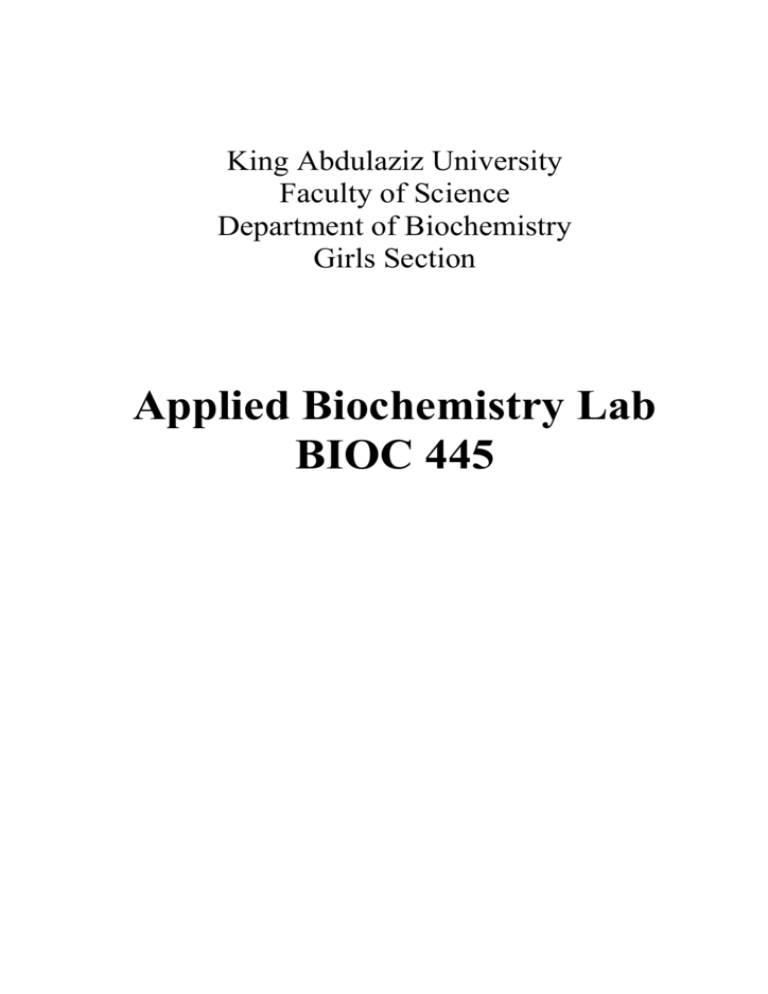
King Abdulaziz University Faculty of Science Department of Biochemistry Girls Section Applied Biochemistry Lab BIOC 445 Table of Contents Lab # Experiment name 1 Isolation of casein from milk 2 Determination of the isoelectric point of casein 3 Digestion of Casein by Trypsin 4 Estimation of lactose in milk 5 Sulpher Dioxide in foods 6 Effect of pineapple enzyme on Gelatin 7 Detection of Pigments and Preservatives Substances and Additives in Milk 8 Enzymatic Browning: activity of Fruit Homogenates 9 Nonenzymatic Browning: Millard Reaction 10 Cheese Making Isolation of casein from milk. Background: There are three kinds of proteins in milk: casein, lactalbumin and lactoglobulin. They are complete proteins because they contain all amino acids essential for building blood and tissue. Casein is the main protein in milk and is present at a concentration of about 35g/l.Casein is a phosphroprotein .It is not a single compound, it is a heterogeneous mixture of α, β, κ caseins which differ from each other in the molecular weight and the amount of phosphorus groups they contain. Casein exists in milk as the calcium salt, calcium caseinate. The white color of milk is due to this salt as well as to emulsified lipids. Principle: Most proteins show minimum solubility at their isoelectric point and this principle is used to isolate the casein by adjusting the PH of milk to (4.5-4.8) its isoelectric point. Casein is also insoluble in ethanol and this property is used to remove unwanted fat from the preparation. Milk is present at a high PH than the isoelectric point of casein, so to precipitate the casein acetic acid is added drop by drop until the isoelectric point is reached.Note that if excess CH3COOH is added the precipitate redissolves. The isoelectric point of a protein(I.E.P.) : is the PH at which the molecule is electrically neutral(net charge is zero). When a protein is charged e.g. with a –ve charge, the –ve molecules repel each other and thus remain in the solution and do not precipitate. But when these molecules are neutral at the I.E.P. they tend to precipitate due to the absence of the repelling forces and, the high molecular weight of protein. After the precipitation of casein it is filtrated and washed with H2O to remove excess acid. The precipitate doesn't dissolve in H2O,alchol or ether but, dissolves in alkaline solutions e.g. KOH forming potassium caseinate .the excess KOH (didn't react with casein) is titrated against 0.1N HCl. Chemicals: - Milk - Sodium acetate buffer [ 0.2mol/L , PH 4.6 ] - Ethanol [95% V/V ] - Ether. - Acetic acid 10% - Distilled water. - 0.1 N KOH - Phenol phethaline indicator. - 0.1 N HCl Equipment: -250 ml Flask. -250 ml beaker. -Hot plate. -Thermometer. -Dropper. -Stirring rod. -Filter paper, muslin, centrifuge. -Buckner filter pump. -Petri dish. -Pipet,10ml,2ml -Funnel -Graduated cylinder, 30ml, 80ml. -Triple beam balance. -Burette holder. -Burette 50ml -Rubber bulb. Procedure: - Measure 30ml of milk and 30ml of water into a 250-ml beaker. - Warm the mixture to about 40C. - Add drop wise with continuous stirring, about 2ml of 10% acetic acid. - Allow the mixture to stand for 5 minutes. - Add 2ml of sodium acetate (to buffer the mixture to a PH of about 4.5). - Stir, cool to room temperature or below and allow the mixture to stand for 5 minutes. -Filter the mixture through muslin, or centrifuge. -Wash the precipitate by suspending it in a small amount of water and refilter through muslin. -Suspend the precipitate in about 10ml of 95% alcohol and the filter at the pump Re-suspense the precipitate in about 10ml of ether and filter at the pump. Add ether-alchol mixture to the precipitate. Press the precipitate using the spatula to remove all traces of solvent. Place the ppt in the flask, add 80ml D.W + 10ml 0.1 N KOH plus few drops phenolphthalein. - Shake well to dissolve all the ppt in KOH. (Note that the volume of KOH required to dissolve the ppt may increase as necessary). -Titrate against 0.1 N HCl,till the disappearance of the pink color, the volume of HCl = VT A blank is done by titrating 10ml 0.1 N KOH + 80ml D.W against 0.1 N HCl.The volume of HCl= VB Calculations: 1L (1 N) KOH = Mwt of casein 1ml (0.1 N) KOH = Mwt of casein 10 × 1000 1 ml (0.1 N) KOH = 0.105 g casein = 1 ml HCl (VB-Vt) x 0.105 = g casein /30ml milk = Y 30 Y x 100 = g casein % Name: No: Experiment 1 Results Sheet VT = ml VB = ml Volume of casein = VB - VT = Post-laboratory questions 1) Define the isoelectric point I.E.P ? 2) what happen to casein at PH of 4.8 ? why ? Experiment 2 Determination of the isoelectric point of casein. Background: Sine the solubility of casein is not affected by heat because it does not contain disulphide bonds and lack the tertiary structure.The solubility of casein depends greatly on the PH of the medium. Proteins are positively charged at low PH and, negatively charged at high PH.The intermediate PH at which a protein molecule has a net charge of zero is called, the isoelectric point of that protein. At this point the the solubility of protein is minimum, but increases with increasing acidity or alkalinity. Certain proteins e.g. gelatin are relatively soluble in water even at their I.E.P .maximum precipitation can be obtained at the the isoelectric point by addition of some reagents such as, ethanol which dehydrates the molecule and allow neutralization of charge. Principle: Using acetate buffer of different PH values the approximate position of the isoelectric point of casein can be obtained by determining the PH of minimum solubility. The PH of any solution can be calculated from Handersonhasselbalch equation. PH = Pka + log [acetate] [acetic acid] Chemicals: - 0.5% casein solution in 0.1M sodium acetate. - Distilled water. - 0.01M acetic acid. - 0.1 M acetic acid. - 1 M acetic acid. Equipment: -Test tubes, 10ml graduated as possible. - Shaker or vortex. - Stop watch. - Pipet, 1ml,10ml,0.2ml, 0.5ml Procedure : - Prepare series of tubes as shown in the following table : Tube no. ml .05% casein solution in 0.1ml sodium acetate ml distilled water ml 0.01M acetic acid ml 0.1M acetic acid ml 1M acetic 1 1.0 2 1.0 3 1.0 4 1.0 5 1.0 6 1.0 7 1.0 8.4 8.0 8.8 8.5 8.0 7.0 7.4 0.6 1.0 ---- ---- ---- ---- ---- ---- ---- 0.2 0.5 1.0 2.0 ---- ---- ----- ---- ---- ---- ---- 1.6 acid - Mix the casein solution sample and water thoroughly and then add the acetic acid accompanied by shaking. - Note and record the degree of precipitation obtained in each test tube at 0,10, 30 minutes. - Calculate the PH in each tube using Henderson-hasselblch equation. Name: No: Experiment 2 Results Sheet Results: PKa = 4.5 Use the following to indicate the precipitate: - no precipitate + few ppt + + Moderate ppt + + + maximum ppt No.of Precipitate Precipitate Precipitate PH for each tubes At 0 min At 10 min At 30 min tube 1 2 3 4 5 6 7 - Calculate the I.E.P. of casein using Henderson-hasselblch: PH= pKa + log [acetate] [acetic acid] - PH of maximum precipitation = I.E.P. = - Comment your results : in tubes 1.2: in tubes 3.4.5.6 : in tube 7: Digestion of Casein by Trypsin. Background: Enzymes that catalyze the hydrolysis of pepide bonds of proteins are called, proteases.These are generally of two types; exoproteases,endo-proteases. Exoproteases liberate amino acids by breaking peptide bonds starting from the end of the polypeptide chain whereas, Endopeptidases break down peptide bonds from the interior of the polypeptide chain. Trypsin is an endoprotease enzyme found in the pancreatic juice which catalyzes the hydrolysis of peptide bons formed from the carboxyl groups of basic amino acids, L-Arginine and L-Lysine Also Pepsin is an endoprotease found in the stomach which catalyzes the hydrolysis of peptide bonds between aromatic amino acids;phenylalanine, tyrosine and tryptophan. Principle: Casein can be hydrolyzed by the protease Trypsin.free amino acids are formed and the reaction can be followed by estimating the number of free amino groups using formal titration. Formaldehyde reacts with the amino group of a.a liberating H+ according to the equation: ~NH.CH2O + H ~NH3 + H.CHO (monomethylol) the solution becomes more acidic and the amount of alkali required to neutralize this increase in acidity is a measure of free amino groups formed. Formaldehyde stops anyfurther activity by reacting with the enzyme protein. Chemicals: - Casein (1%,0.8%,0.6%,.05%). - Trypsin . - 0.1N NaOH. - Acetic acid. - Sodium acetate buffer (PH =8.5). - Ice. - 40% neutralized formaldehyde. - Phenol phethaline. - distilled water. Equipment : - pipet,5ml,0.2ml,1ml. - Water bath 37ْC . - Thermometer. - Conical flask 250ml. - Volumetric flask, 100ml. - Balance. - PH meter. - Burette 50ml. - Dropper. -Centrifuge with refrigerator. The preparation of substrate: Prepare 1% casein by dissolving 1g in 100ml sodium acetate buffer (PH = 8.5).the other dilutions (0.8%,0.6%,.05%). can be done from this solution. Procedure: - pipette 1ml of casein solutions, each concentration in separate test tube. - Add 0.2ml trypsin to each tube. - Incubate the mixture at 37ْC for 30 minutes. - Add1ml 12% TCA solution. - Cool the mixture rapidly in ice. - Centrifuge for 5 minutes at 3000 rpm,collect the supernatant, measure its volume, this is the volume of free amino acid. - In a conical flask add 5ml of 40% neutralized formaldehyde to the supernatant, followed by a few drops of ph.ph - Titrate against 0.1N NaOH, till a faint pink color is formed.the amount of NaOH added(the titer no.) is a measure of the free amino groups produced. - Calculate the concentration of the free amino acids by the equation : N x V(a.a) = N x V(NaOH) - Draw a standard curve, titer no. against concentration. Name: No: Experiment 3 Results Sheet No of tubes 1 Concentration of amino acids N x V(a.a) = N` x V`(NaOH) Titer no. volume of NaOH 2 3 4 Plot a standard curve, titer No. against the concentration. Experiment 4 Estimation of lactose in milk. Background: Lactose is a disaccharide that consists of β-D-galactose and β-Dglucose molecules bonded through a β1-4 glycosidic linkage. Lactose makes up around 2-8% of the solids in milk. The name comes from the Latin word for milk. Lactose is a disaccharide consisting of two subunits, a galactose and a glucose linked together. an enzyme called lactase (β1-4 disaccharidase) is secreted by the intestinal villi, and this enzyme cleaves the molecule into its two subunits for absorption. A-By Benedict quantitative reagent. Principle: Lactose in milk is estimated in the clear filtrate after precipitation of the proteins with acetic acid, tungestic acid, T.C.A, or colloidal iron. Procedure: Preparation of the filtrate: 1) In a conical flask place 5ml of milk + 1.5ml of 10% sodium tungestate + 1.5ml of 2/3 N H2SO4 (or 3% acetic acid ) drop by drop, with continuous shaking. 2) Complete the volume of the solution to 25 ml with water. Wait until the precipitate settles down. 3) Filter into a dry clean beaker, the filtrate must be clear. If not refilter again. Estimation of lactose: 1) In a test tube, place 5ml of Benedict's quantitative reagent + 1g Na2CO3 2) Place the tube in a boiling water bath for 5 minutes. 3) with 1ml pipette, start titrating the constituents of the tube with the filtrate (sugar solution). The end point is reached when all the blue is replaced by white precipitate. 4) Dilution of sugar: if the titration takes less than 2ml of sugar solution it is recommended to dilute it, in order to minimize the error. Do not dilute too much, to avoid prolonged heating . e.g. if the titration takes 1ml of sugar solution, therefore, it could be diluted 3 times, i.e. to take approximately 3ml in titration Take 5ml of sugar solution, add 10 ml of water Dilution factor = Final volume (15) = 3 Initial volume (5) Calculations: 5ml Benedict are reduced by 0.0134 g lactose 5ml Benedict are reduced by Yml lactose solution Yml lactose solution contains 0.0134 g lactose 100 ml lactose solution contains Z g of lactose Z = 100 x 0.0134 x dilution = Y ml g lactose % B- By Fehling reagent: Procedure : 1) 50ml of milk + drops of 3% acetic acid till the casein precipitates. 2) Centrifuges 3 minutes 3) Filter. 4) 0.5ml of filtrate + 5ml Fehling A + 5ml Fehing B + 9.5 ml H2O (boil for 2 minutes then cool) 5)Add 7.5ml 1N H2SO4 + 1 g KI, put in a dark place. 6)Add 1 ml 1% starch. 7) Titrate using Na2S2O3 till end point (white precipitate). Note: to prepare the blank do the same as in the test tube but replace 0.5ml of filtrate with 0.5 ml water. Calculation: B –T x 13.65(mg lactose) x 100 = 2 x volume of sugar us Name: mg lactose % No: Experiment 4 Results Sheet Estimate the percentage weight of lactose using: A- Benedict quantitative reagent. B- Fehling reagent: Experiment 5 Sulpher Dioxide in foods. Background: The sulfite in diet occurs mainly as food preservative. The process by which sulfite is applied to food is known as,Sulfuring, and is used in food industry for the following applications: (1) As antimicrobial agents. (2)To preserve colors of various products such as, canned bears,orange juice,grape juice.This is achieved by bleaching away degradation products that would otherwise discolor the food or bleaching molasses and cherries before adding artificial coloring. (3) preserve dried fruits. The source of sulfite additives include: (1) Sodium metabisulfite (Na2S2O5)or Ca,K,NH4 bisulfite.This compound is hydrolyzed to bisulfite when dissolved in water. (2) and exposure to fumes of burning sulfer this is used in case of dried fruits,it is usually mixed with antiseptics as, salicylates or benzoate. The preservative has some degree of toxicity because it reacts with sulfydryl groups, aldehyde or ketone,enzyme bound NAD-FAD and also react with thiamine in food destroying this vitamine Beside people suffering from asthma cannot tolerate sulfite because they have low level of sulfite oxidase leading to impaired of sulfite catabolism and removal. Principle: Direct titration method is applied to light-colored liquid such as, white grape juice to determine the amount of sulfer dioxide in such a juice. NaOH I2 + H2SO4 SO2 S2O3 Blue Procedure: - Add 50 ml of the sample to 25 ml of 0.1 N NaOH in a 200 ml flask, shake thoroughly and set aside for 15 minutes with occasional shaking. - Add 10 ml of dilute H2SO4 (1:3) and a little starch indicator. - Titrate the mixture with (0.002 N) iodine solution introducing it quite rapidly until blue color is formed which persisted for several minutes. Calculations: 1L (1 N) of 2eq I = Mwt of SO2 1L (1 N) of 2eq I = 64 g of SO2 64_______ 1 ml 0.002N of I = 1000 x 500 x 2 1 ml 0.002 of I = .000064 g of SO2 No. of gm of SO2 present in sample = X ml x 0.000064 1 G % of sulpher dioxide in grape juice = X ml x 0.000064 x 100 50 Name: No: Experiment 5 Results Sheet Type of White grape juice Titer Number (ml) G% of Sulpher dioxide Experiment 6 Effect of pineapple enzyme on Gelatin. Background: Pineapple is a tropical fruit, belongs to the bromeliad family. Pineapple fruit contains an enzyme that breaks down or digest proteins. This protease enzyme in pineapple is called, bromelain. Recent research has suggested that bromelian may have some effect on the immune system. Many fruits have a variety of protease enzymes, papaya contains an enzyme called, papain that digest protein, kiwi has actinidin, and figs have ficin. Bromelain and papain are extracted and sold in commercial products as meat tenderizers. Principle: Jello(gelatin) is a protein that is made out of skin, bones of animals, commonly cows. If this protein is treated with a protease enzyme it will be degraded and lack the ability to solidify as the plain gelatin usually does. Materials: - Commercial gelatin. - Distilled water. - Petri dishes. - pipette. - Hot plate. - Fresh , canned pineapple juice. - Meat tenderizer. - Glass rod. - Beakers. Procedure : - Prepare the gelatin by dissolving g of gelatin in ml distilled water. stir with a glass rod until it completely dissolved, warm in a hot plate if necessary. ml gelatin in each Petri dish. - Pipette - Leave the first dish as a blank. - Using a small spoon add the fresh, canned pineapple juice into the second and third dishes respectively. - Sprinkle the meat tenderizer on the fourth dish. - Mix after any addition with glass rod. [Note that the juices and meat tenderizing powder should be added as soon as the gelatin is poured before it hardens]. - Allow the dishes to stand for 6-10 minutes. - Record your observations by comparing the second, third, fourth gelatin samples with the blank. Name: No: Experiment 6 Results Sheet Observation Type of Gelatin Plain gelatin (gelatin+water) Plain gelatin + Fresh pineapple juice Plain gelatin + canned pineapple juice Plain gelatin + Meat tenderizer Comment Post-laboratory questions Why can't we put fresh pineapple on gelatin? Experiment 7 Detection of Pigments and Preservatives Substances and Additives in Milk. Introduction: It's almost impossible to eat food without preservatives added by manufacturers during processing. Manufactures add preservatives mostly to prevent spoilage during the time it takes to transport foods over long distances to stores and then our kitchens. Preservatives serve as either antimicrobials or antioxidants both .As antimicrobials, the prevent the growth of molds, yeasts and bacteria. As antioxidants, they keep foods from becoming rancid, browning, or developing black spots. Rancid foods may not make you sick, but they smell and taste bad. Antioxidants suppress the reaction that occurs when food combine with oxygen in the presence of light, heat, and some metals. Antioxidants also minimize the damage to some essential amino acids the building blocks of proteins and the loss of some vitamins. A food manufacturer must get FDA approval before using a new preservatives, or before using a previously approved preservative in a new way or in a different amount. In its petition for approval, the manufacturers must demonstrate to FDA that the preservative is safe for consumers. Chemicals: - Milk, yogurts, juice. - Ether. - Distilled water. - NaOH (0.1 N). - Dilute H2SO4 -Turmeric in alcohol. -Neutral FeCl3 - Dilute HCl. -Para phenyl diamine 2% - H2SO4 73.5% with 0.025 stannous chloride. -Ice. - FeCl3 in conc. HCl. Equipment: -Large test tubes. -Beakers. - water bath. -Hot plate -Oven (100-105C) -Flask. - Funnel. - Filter paper. - Pipette 5ml, 10ml, 20ml. - Graduated cylinder,100ml. - Dropper -Thermometer. - Centrifuge. - Ultraviolet light. - Stop watch. - Rubber bulb. Test For Additives: 1) Pigments addition: -Mix 10ml of milk with 10ml of ether. -leave for 10 min and note the color formed. -If yellow color result that due to pigment addition, the color concentrate depend on color substances additives. 2) Formaldehyde addition: -Add 5ml of milk to a beaker 20ml and add 5ml distilled water, then 15ml of reagent (conc.HCl,FeCl3) -Heat gently in water bath. -If pink or violet color formed that is due to formaldehyde in your sample. 3) Boric acid or Borate or Borax addition: -Put 100ml sample in a beaker 250ml.Then add 0.1 N NaOH until the milk (sample) reach to alkali. -Evaporate completely to dryness on hot plate. -Fire in oven (100-105C) to form ash. -Dissolve ash in dil-HCl and filtrate. -Add 6 drops from saturated tumeric solution in alcohol, then evaporate to dryness in water bath. -If the pink color result, that is boric acid added. 4) Salycilic acid addition: - Add 5ml of dilute H2SO4 to 20ml of milk in beaker 250ml. - Shake gently, then add 20ml ether, shake strongly. - Evaporate ether to dryness by hot plate at low temperature. - Add 5 drops of neutral ferric chloride solution. - If the deep red color or violet formed, that is due to salicylic acid added. 5) Hydrogen peroxide addition: -Add 2 drops of ( 2% p-phenyl diamine) solution to 5ml of milk, mix. - If the bluish violet result, that is due to the addition of H2O2 6) Hypochloride addition: - Add 3ml of (73.5% H2SO4, 0.025 stannous chloride) reagent to 3ml of cold milk at (0-5C) in test tube. Cool in ice bath to (0-5C) for 3 minutes. - Mix, by vortex, centrifuge for 3 minutes (2500 rpm/min). -If a yellow color formed under the ultraviolet light the milk contains hypochloride. Name: No: Experiment 7 Results Sheet Test the presence of pigments and additives then fill the table below: Test for Additive s Type of milk Pigment s Formaldehy de Comment on your results: Bori salicyli c c acid acid Hydroge n peroxide Hypochlori de Experiment 8 Enzymatic Browning: activity of Fruit Homogenates. Introduction: Enzymatic browning of cut or damaged fruits and vegetables is due to the action of polyphenol oxidases (collectively called phenolase) on phenolic substrates; the reaction occurs at room temperature .These enzymes catalyze oxidation of phenolic substrates to quinines which subsequently polymerize to give brown-black pigments. For oxidative browning to occur, three components must be present, namely: enzyme, substrate and oxygen. A number of methods are used both commercially and domestically to inhibit this reaction. These include destruction of the enzyme by heat, elimination of oxygen, control of pH, and the use of chemical inhibitors. The standard method for examining enzymatic browning in-vitro is to use a model system consisting of fruit homogenate as the enzyme preparation and the phenolic compound, catechol as the substrate. Chemicals: - Fresh fruits (apple, pear, banana, etc). - 0.5 M catechol. - 0.01 M citrate buffer,pH(3.4.5.6.7). - NaCl solution (115.000 ppm). -Chloride (1000 ppm). - Cl ions (2000ppm) - Distilled water. - Sodium bisulphate solution (5750ppm). - Sulphite (100 ppm). Equipments: -Blender. - Balance. - Measuring cylinder 100ml. - Filter paper. - Buckner funnel. - Ice. - Water bath 25C - Spectrophotometer-cuvette. - Stop watch. - Pipettes, (0.2,0.3, 0.5,0.1ml). - PH meter. Procedure: Each student is to do tests on one fruit extract at three different pH's 1. Tissue extract preparation : Prepare tissue extracts of fresh fruits ,e.g. apple ,pear, or banana, by blending 10g of fruit with 100ml distilled water, then filtering using Buckner funnel. It is not necessary to filter the whole extract since a few ml are required. Extracts should be clear and must be stored in ice bath for a short time (same practical session only). 2. Measurement oxidation rate : The method is based on the oxidation of catechol at pH 5 and 25ْC, with the color development being assayed by absorption by absorption at 420 nm in a spectrophotometer. Switch on a spectrophotometer and allow to warm up for 10 minutes. Set the wavelength to 420nm, and zero the instrument using a blank consisting of 10ml 0.01 M citrate buffer pH 5.1 ml 0.5M catechol.And 0.5 ml distilled water. Once the instrument is zeroed, prepare the sample test tubes near the spectrophotometer so that there is no delay in placing the samples in the instrument. Place in a clean test tube 10ml 0.01 M citrate buffer, 1ml catechol and 0.5 ml of the enzyme solution of clear tissue extract .It is important to add the tissue extract last. Mix well, quickly transfer the solution to a cuvette. Place the cuvette in the spectrophotometer, and read the absorption every minute for 20min or until the activity ceases. Start timing from when the enzyme solution is added to the test tube.You must be quick with the transfer to the cuvette to record the 1 min reading. 3. Effect of pH changes on enzyme activity : Repeat the exercise using pH's 3.4.6 and 7 buffer solutions instead of the pH 5 one. New separate blanks (with each pH) are required. perform these parts of the practical exercise for one fruit only. Plot these results on the same graphs as those for the pH 5 part, with one graph (i.e. PH's 3-7) for each fruit extract. Next share the results with other members of your practical group so you have all the data for the three different fruit homogenates (i.e. apple, pear, and banana). 4.Effect of Added Sodium Bisulphite and Sodium Chloride on enzyme Activity. Next, repeat the exercise twice at pH 5, once with added sodium bisulphate (50 ppm) and once with sodium chloride (1000 ppm) All solutions must be freshly prepared. [a] Effect of added sodium chloride on enzyme activity: In one tube, add 0.2 ml of the concentrated NaCl solution (115.000 ppm) to the model system sample to achive 2000ppm Cl ions. Perform this exercise for one fruit. Additionally a new blank (1000 ppm ) needs to be prepared by adding 0.2ml of the concentrated NaCl solution (115.000 ppm) as part of the preparation of the pH blank detailed earlier (i.e. in the earlier blank replace addition of 0.5 ml distilled water with the addition of 0.3 ml of distilled water and 0.2ml of the concentrated NaCl solution). [b] Effect of added sodium bisulphate on enzyme activity: In another tube, add 0.2ml of the concentrated sodium bisulphate solution (5750 ppm) to the model sample system to achive 100ppm sulphite. Perform this exercise for one fruit. Additionally a new blank (100 ppm sulphite ) needs to be prepared by adding 0.2ml of the concentrated sodium bisulphate solution (5750 ppm) as part of the preparation of the pH blank detailed above (i.e. in the earlier blank replace addition of 0.5 ml distilled water with the addition of 0.3 ml of distilled water and 0.2ml of the concentrated sodium bisulphate solution). Results: 1. Plot absorbance ( Y axis ) versus time ( X axis ) for each ph and each fruit homogenate ( each fruit in a different graph ). Also include the plots for the NaCl and bisulphate trials with the plots of the 5 different pH's. Next, determine and tabulate the polyphenol oxidase activity (where the slope is greatest) of the three fruit extracts at pH's 37(express as increase in absorption /minute for the first 2 minutes, i.e. A2min- A1min ) from the graphs( results for each fruit homogenate are to be shared between group members). 2. Determine the effect of increased acidity on phenol oxidase activity, effect of pH by plotting activity (A2min- A1min ) versus pH (x axis ) on another graph for each fruit homogenate? 3. Determine the effect of added sulphite and chloride ions on polyphenol oxidase activity.why is there a difference in the inhibition of sulphite ions relative to chloride ions ? 4. Discus why the graph obtained in [1] above flattens off with time. 5.Comment in your result. Name: No: Experiment 8 Results Sheet - The pH of the buffer used = - Read the absorbance at 420nm each min for 20 minutes and tabulate your results: Time Absorbance 1 2 3 4 5 6 7 8 9 10 11 12 13 14 15 16 17 18 19 20 - Plot absorbance ( Y axis ) versus time ( X axis ) for your selected pH.? Comment on your graph? Name: No: Experiment 8 Results Sheet -Plot the activity (A2 min – A1 min) versus pH. pH 3 4 5 6 7 activity (A2 min – A1 min) Experiment 9 Nonenzymatic Browning: Millard Reaction. Introduction: Nonenzymatic browning is purely chemical and occurs by several mechanisms involving reactive sugars and amino compounds (e.g. lysine). Nonenzymatic browning is found in food processing operations involving dehydration/condensed milk).The extent of this browning will increase with concurrent increase in process pH and/ or temperature. In both case, complex"melanoidin" browning polymers are formed. These may have a significant effect upon the color, flavor, and nutritive value of the processed food product. When reducing sugars (e.g. glucose, fructose, lactose, maltose) and amino compounds (e.g. amines, amino acids, proteins ) are present together in a system (e.g. food), browning reactions may occur. These reactions are not enzyme-catalyzed but are affected by temperature , concentration of the reactants, pH, inhibitors or preservatives, etc. Browning reactions may be desirable (e.g. crust on baked goods, color of caramel, flavor, color of maple syrup) or detrimental ( darkening of dehydrated fruits , eggs, vegetables, canned or dried milk) to the food. The following experiments attempt to gauge the effect of several variables and the rate of the browning in a model sugar-amine browning system. Chemicals: -50ْ Brix invert sugar. - 10% glycine. - Buffer pH (3,4,5,6,7,8) - Sodium metabisulphate solid. - Distilled water. Equipment: - 15 x 150 ml test tubes. - Vortex. - Foil. - Water bath. - Stop watch. -Thermometer. - Spectrophotometer. - Pipettes - Balance. Procedure: 1- Trial of the model system. A model browning system is as follows: to a test tube, add 4ml 50ْ Brix invert sugar + 1ml 10% glycine + 1ml pH 8 buffer.Mix well, cover the tops of the tubes with foil and incubate in a water bath at 100ْC for 30 minutes.The color produced may be read at 420nm on the spectrophotometer.the tubes may have to be diluted so that a reading can be obtained on the spectrophotometer.If this is necessary, add the same amounts of diluent to all tubes, about 10ml distilled water is usually needed. The above is only a model for the 10 mini experiments to be performed below. 2- Final Experiments using the model system. Using the above model system ,set up the following 10 test tubes ( all of the same size) and record your results in a table. Tubes 1-6 : effect of pH : 3,4,5,6,7,8 at 100 ْC for 30 min. Tube 7 : Effect of temperature : 70ْC at pH 8 for 30 min. Tube 8 : 4ml 50ْ Brix invert sugar + 1 ml of 10% glycine + 1ml pH 8 buffer + 0.1 g sodium metabisulphate, at 100ْC for 30 min. Tube 9 : 4ml 50ْ Brix invert sugar + 1ml disilled water (instead of glycine) + 1ml pH 8 buffer , at 100ْC for 30 min. Tube 10 (blank): 4ml 50ْ Brix invert sugar + 1ml disilled water (instead of glycine) + 1ml pH 8 buffer , at 25ْC for 30 min. The blank is used to calibrate the absorbance to zero before each measurement. Results: Plot the absorbance versus pH and explain the effect of pH. Name: No: Experiment 9 Results Sheet - Plot the absorbance versus pH. Tube Absorbance 420nm 1 2 3 4 5 6 7 8 9 - Compare the tubes 1-6? What is the effect of different pH's ?What is the optimum pH for the browning? Name: No: Experiment 9 Results Sheet - Compare the tubes 6,7 what is the effect of temperature? - Compare the tubes 6,8 what is the effect of silver chloride addition? Experiment 10 Cheese Making . Introduction: In this activity you will be fermenting milk products. The action of bacteria in milk causes a buildup of lactic acid. This lactic acid causes the milk to curdle, forming a solid curd, and a liquid whey. The curd is then separated from the whey and aged to make cheese. The physical characteristics of the cheese depend on many factors. Below is a basic "recipe" for making cheese. You will be responsible for making a control sample following this formula and at least one other batch of cheese in which you have changed one factor. You need to hypothesize what differences your experimental group(s) will have as compared to your control. Be sure to follow aseptic technique and use only food-grade containers for this experiment. You must submit a proposal on what your experimental group(s) will entail before beginning this laboratory work. Materials: 500 mL whole milk hot plate fine-mesh cheesecloth labels 50 mL, 500 mL and 600 mL containers 50 mL buttermilk thermometer cotton twine 50 mL, 500 mL and 600 mL measuring devices Cautions: 1. Wash hands thoroughly with antibacterial soap and water before and after completing each step of the laboratory. 2. Be aware of shock and burn hazards when using the hot plate 3. Wear goggles and laboratory apron Procedure: Day 1 1. Make sure all materials, equipment and your hands are as clean as possible. Wash hands before handling any materials. 2. Pour 500 mL whole milk into your 600 mL container and 50 mL buttermilk into your 50 mL container. 3. Heat the whole milk to 37 degrees C. 4. Add the buttermilk to the whole milk and stir well. 5. Cover the container with cloth or paper. 6. Incubate at between 25 and 35 degrees C for 48 hours or until a firm curd has separated from the whey. Day 2 1. Prepare a piece of cheesecloth that will be thick enough and large enough to hold your curd. 2. Pour your curd into the cloth. Collect the whey in the 500 mL container. Gather the edges of the cloth to form a bag. Tie the bag with the twine and hang it to continue draining. After it has fully drained, discard the whey and place the bag in the refrigerator. Day 3 No work necessary today. Day 4 Remove the cheese and enjo Experiment 11 Determination of acetic acid content in commercial vinger Background: Vinegar is a sour-tasting liquid made from the oxidation of ethanol in wine, cider, beer, fermented fruit juice, or nearly any other liquid containing alcohol. It can also be made by certain bacteria operating on sugar-water solutions directly, without intermediary conversion to ethanol. Commercially available vinegar usually has a pH of about 2.4. Vinegar is a dilute form of acetic acid, Natural vinegars also contain smaller amounts of tartaric acid, citric acid, and other acids. Principle: Vinegar is conveniently analyzed by titration with sodium hydroxide. Procedure: 1- Place 1 ml of the commercial vinegar (apply different types) into a beaker and rains the volume with distilled water to 25ml. 2- Add 2g of activated charcoal and shake well. filter into clean and dry beaker. 3- Take 5 ml portion of the filtrate into a conical flask, and add 2 drops of phenolphthalein. 4- Titrate against 0.1 N NaOH until the appearance of the pink color. 5- Repeat the titration once again and calculate the amount of acetic acid in your vinegar solution. Calculations: ( N x V ) NaOH = ( N x V ) CH3COOH N CH3COOH = ( N x V ) NaOH V CH3COOH Wt CH3COOH = N x V .eq.wt / 1000 Name: No: Experiment 11 Results Sheet Type of vinegar Titer no. V NaOH N CH3COOH Wt CH3COOH Post-laboratory questions 1-Why did we add charcoal to vinegar ? 2-Which type of vinegar has the highest amount of acetic acid?

